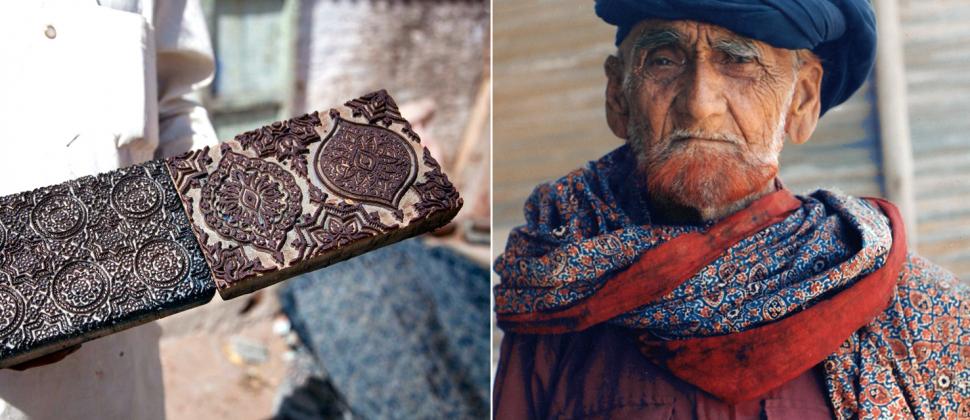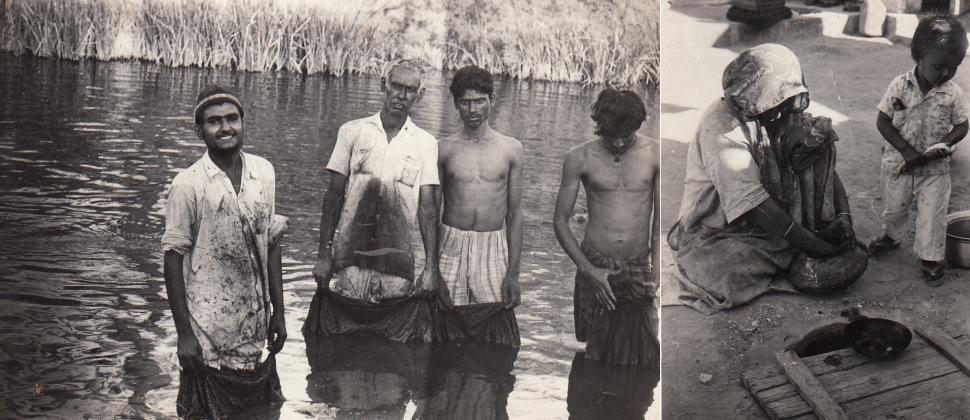Generations of Indigo
Ajrakh cloth carries many meanings. The popular story amongst local printers is that Ajrakh means “keep it today.” It is also linked to azrakh, the Arabic word for indigo, a blue plant which thrived in the arid ecology of Kachchh until the 1956 earthquake. Ajrakh patterns use complex geometry to create starry constellations in indigo, madder, black, and white across lengths of cloth. The shapes and motifs of Ajrakh echo the architectural forms of Islamic architecture’s intricate jali windows and trefoil arches.

Ajrakh blocks | Maldhari wearing an Ajrakh shoulder cloth
Ajrakh is a time-honored emblem for the local communities of Kachchh. Nomadic pastoralist and agricultural communities like the Rabaris, Maldharis, and Ahirs wear Ajrakh printed cloth as turbans, lungis, or stoles. It was given as a gift for the Muslim festival of Eid, for bridegrooms, and for other special occasions. The colors of a true Ajrakh textile are fast. The cloth is made in a sixteen step process of washing, dyeing, printing, and drying, which requires a high level of skill and concentration in order to keep colors fast and even. Pomegranate seeds, gum, Harde powder, wood, flour of Kachika, flower of Dhavadi, alizarine and locally cultivated Indigo are just some of the natural resources that printers in this craft.
The Rivers and Roads of Today
Long ago, printers flocked to the Dhamadka River, where they dyed and washed their cloths with ease. Now, the Dhamadka River has dried up, and the shifting water tables in Kachchh due to seismic activity have reduced the availability and quality of the water. The block printers of Bhachau and Rapar lack proper water facilities at their villages. In Dhamadka, the water in bore wells has a high iron content affecting the color quality of vegetable dyes. After 2001, Ajrakhpur was founded in a search for better quality water.

Block printers at the Saran River in Dhamadka | Preparation of Indigo dye
Chemical dyes are a major source of pollution in block printing villages. Various toxic dyes and chemicals are disposed of in village fields without any form of treatment. These chemical dyes are cheap and affordable, easily made in bulk. Today, few printers use vegetable dyes. Natural resources once used to create natural colors are no longer accessible locally because of the ecological effects of the 1956 and 2001 earthquakes and the loss of ecology cover from recent industrialization.
Earlier, the block printers had a close friendship with their local clients. Now, with the introduction of more affordable synthetic cloth and a shifting marketplace, those community linkages have broken. As a result, many traditional forms of dress and patterns are extinct. The traditional lungi is rapidly losing its share. Other products like Pada are also being worn in synthetic fabrics more often. Kanbi Patel women have adopted synthetic saris as their outfit. Mostly, printers create dress material for national and international buyers in a highly competitive marketplace.
The Possibilities for Ajrakh
Water management issues pose a severe threat to dyeing and printing practices in Kachchh. Through a series of surveys, Khamir has identified a central need to recharge water tables with better water management. This includes facilitating water treatment in villages and creating systems for recycling water used in dyeing. Realizing the immediate need for water security, Khamir carried out the a pilot of the water treatment through a small Effluent Treatment Plant. Encouraged by these results, Khamir is now working with the artisans to establish a large scale treatment plant to be managed at the village level. Additionally, Khamir attempts to improve natural dyeing practices through programs like our workshop with Dastkar Andhra experts. Promoting eco-friendly dyes along with better treatment practices will increase sustainability of the local ecology and the craft.
Apart from water, Khamir has taken other steps to continually revitalize this sector. This includes introducing new block designs, products and raw materials to the printing families and facilitating platforms to showcase products all over India and internationally.
Read about the our 2014 exhibition honoring the Block Printers, Kachchh Ji Chhaap.